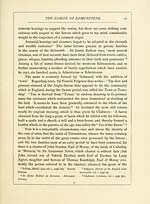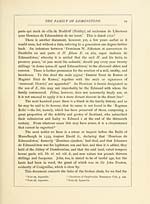Genealogical account of the family of Edmonstone of Duntreath
(36) Page 18 - Henricus de Edmundiston --- 1248
Download files
Complete book:
Individual page:
Thumbnail gallery: Grid view | List view

1 8 GENEALOGICAL ACCOUNT OF
Earldom of Moray from Robert the Second in 1 37 1. But as these lands
of Culloden were in possession of Sir William Edmonstone, the first of the
Duntreath line, and himself nearly related to Robert the Second, it seems
likely that they were derived from the Setons by a family transfer.
Farther, in a charter of resignation, dated Edinburgh, 28th November 142 1,
by ' John de Annandia,' of the lands of Myles, ' Reverendo et Superiori
domino suojohanni domino Settone,' among other witnesses are Archibald
Edmonstone, Knight, and William, his son and heir.
From these various causes I think it highly probable that an Edmund
of the race of Seton received the lands of Edmonstone in Midlothian as his
appanage, to which he gave his name, and that from him the family is
descended. Nor is the stock an ignoble one. According to Douglas, the
Setons are of Norman extraction. Secher, son of Dougal de Say, obtained
lands in East Lothian from David the First, and hence the name Say-town.
At a later period the family rose into great distinction. The chief branch
was ennobled as Barons Seton in 1448, and as Earls of Winton in 1600.
George, the fifth Earl and eleventh Baron, was attainted for his concern in
the rebellion in 1715, and, having died without male issue in 1745, the
Earls of Eglinton, who were Setons in the male line and Montgomeries
only in the female, became heirs-male of the family. The title by a
specialty was saved from forfeiture, and the Earldom of Winton was
accordingly taken up by the present Earl of Eglinton in 1840. From
another branch of the Seton family the ducal House of Gordon, now Mar-
quisses of Huntley, descend ; and cadets were raised to the peerage as Earls
of Dumfermline, and also as Viscounts Kingston, now extinct.
Presuming, therefore, that the Setons may be the original stem, at
what period did the House of Edmonstone appear as a distinct family ?
This it is impossible to fix precisely, but there is ground for referring it to
about the commencement of the thirteenth century. The earliest mention
of the name I have met with, is an assignation of lands by Johannes de
Gallard to the abbey of Dumfermline, to which Henricus de Edmundiston
is witness, dated at Musselburgh, 1248, tempore Alexander II. The same
person is, moreover, referred to four years later, in charter of mortification,
by William de Craigmillar, whereby he gives in alms, to the church and
abbey of Dumfermline ' quandam toftum terre in Craigmillar, in Australi,
Earldom of Moray from Robert the Second in 1 37 1. But as these lands
of Culloden were in possession of Sir William Edmonstone, the first of the
Duntreath line, and himself nearly related to Robert the Second, it seems
likely that they were derived from the Setons by a family transfer.
Farther, in a charter of resignation, dated Edinburgh, 28th November 142 1,
by ' John de Annandia,' of the lands of Myles, ' Reverendo et Superiori
domino suojohanni domino Settone,' among other witnesses are Archibald
Edmonstone, Knight, and William, his son and heir.
From these various causes I think it highly probable that an Edmund
of the race of Seton received the lands of Edmonstone in Midlothian as his
appanage, to which he gave his name, and that from him the family is
descended. Nor is the stock an ignoble one. According to Douglas, the
Setons are of Norman extraction. Secher, son of Dougal de Say, obtained
lands in East Lothian from David the First, and hence the name Say-town.
At a later period the family rose into great distinction. The chief branch
was ennobled as Barons Seton in 1448, and as Earls of Winton in 1600.
George, the fifth Earl and eleventh Baron, was attainted for his concern in
the rebellion in 1715, and, having died without male issue in 1745, the
Earls of Eglinton, who were Setons in the male line and Montgomeries
only in the female, became heirs-male of the family. The title by a
specialty was saved from forfeiture, and the Earldom of Winton was
accordingly taken up by the present Earl of Eglinton in 1840. From
another branch of the Seton family the ducal House of Gordon, now Mar-
quisses of Huntley, descend ; and cadets were raised to the peerage as Earls
of Dumfermline, and also as Viscounts Kingston, now extinct.
Presuming, therefore, that the Setons may be the original stem, at
what period did the House of Edmonstone appear as a distinct family ?
This it is impossible to fix precisely, but there is ground for referring it to
about the commencement of the thirteenth century. The earliest mention
of the name I have met with, is an assignation of lands by Johannes de
Gallard to the abbey of Dumfermline, to which Henricus de Edmundiston
is witness, dated at Musselburgh, 1248, tempore Alexander II. The same
person is, moreover, referred to four years later, in charter of mortification,
by William de Craigmillar, whereby he gives in alms, to the church and
abbey of Dumfermline ' quandam toftum terre in Craigmillar, in Australi,
Set display mode to:
![]() Universal Viewer |
Universal Viewer | ![]() Mirador |
Large image | Transcription
Mirador |
Large image | Transcription
Images and transcriptions on this page, including medium image downloads, may be used under the Creative Commons Attribution 4.0 International Licence unless otherwise stated. ![]()
| Histories of Scottish families > Genealogical account of the family of Edmonstone of Duntreath > (36) Page 18 - Henricus de Edmundiston --- 1248 |
|---|
| Permanent URL | https://digital.nls.uk/95353887 |
|---|
| Description | A selection of almost 400 printed items relating to the history of Scottish families, mostly dating from the 19th and early 20th centuries. Includes memoirs, genealogies and clan histories, with a few produced by emigrant families. The earliest family history goes back to AD 916. |
|---|

